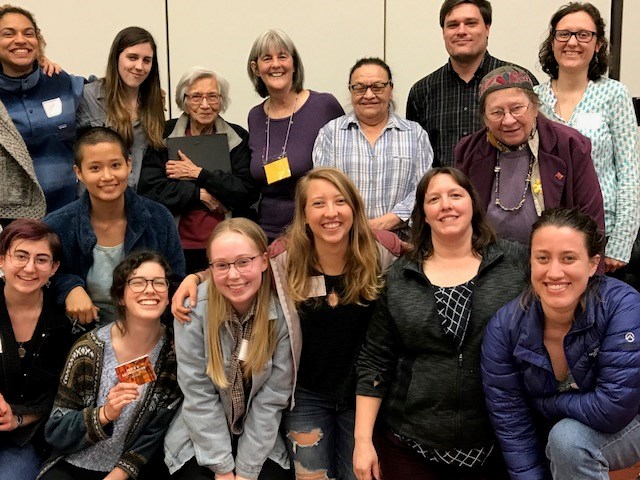How do you teach a painful history and keep hearts open? On Friday night the Squamish Multifaith Association, Squamish Nation elders, and university students stepped onto blankets to explore Canada’s history of colonization.
“We’ve wanted to try the blanket exercise for a couple of years,” said organizer Geraldine Guilfoyle, of the Squamish Multifaith Association.
The blanket exercise was developed in 1996 by the Aboriginal Rights Coalition, and learners stepping onto the blankets adopt the role of Indigenous people for a “participatory” lesson.
The script read aloud during the activity has been kept updated by human rights organization KAIROS, which requires facilitators to undergo training and work in partnership with Indigenous teachers and elders when using it.
On Friday evening Quest University students gathered at Totem Hall to hear a presentation from Squamish educator Charlene Williams and receive a lesson on weaving. After a meal together the group began the blanket exercise.
The exercise begins with participants walking together on several blankets laid out on the floor, trading traditional items and greeting each other to represent First Nations in Canada pre-contact.
As it continues, the history of Canada’s colonization is spoken aloud by facilitators.
Blankets are removed, to represent stolen lands, or separated to represent families torn apart by enforced borders, residential schools, and the 60s scoop. Participants standing in the centre are directed to move as the available land disappears.
During the reading of the history of residential schools, Squamish elder Gwen Harry (Chisa) paused to point out that she was taken from her family to attend school in Alert Bay.
Some participants are asked to leave the blankets, representing deaths from disease and conflict. Those in the centre look to the east, west, north and south remembering many different and diverse groups across Turtle Island.
While much of the history is dark, the exercise ends with some blankets being returned, recognizing Indigenous resilience and reconciliation.
The voices of leaders like Attawapiskat youth Shannen Koostachin are shared by participants, who each have scrolls to read aloud.
It’s more emotional and direct than reading from a history book — and that’s the point, said Squamish elder Donna Billy (Sisolia).
“I think the youth learn better hands on than out of a book. The book has no feeling. Tonight there was feeling, there was acknowledgement,” she said. “We’ll get closer to no racism if everyone works together. All my life I’ve been striving for the world to be more at peace.”
“It’s very important to teach the youth. The sooner the better,” she added.
Guilfoyle said she hopes to bring the exercise to classrooms and other groups in Squamish, but wanted to make sure Squamish Nation representatives thought it was a useful tool.
“We want to have youth more engaged, and we thought it would be a good exercise for them,” she said. “We also wanted to get the feedback from the Squamish Nation elders, and if they felt it was a good exercise to pursue, we wanted to get their blessing to do it, and I think we have achieved that.”



